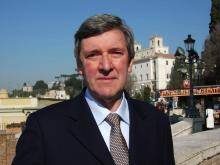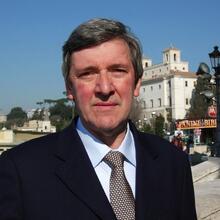Francis, the first Jesuit pope in history, is a missionary. Like his fellow Jesuits Francis Xavier and Matteo Ricci before him, he passionately desires to share “the joy of the Gospel” with the peoples of Asia, a continent with a rich diversity of peoples, religions and cultures, where 60 percent of the world’s population lives, among them a tiny Christian minority.
He has just been to South Korea, where he met some 100 Asian bishops and thousands of young Catholics from 30 Asian countries and beatified 124 martyrs. He will visit Sri Lanka and the Philippines in January.
Francis is the third pope to visit Asia. Paul VI went twice, in 1964 and 1970; John Paul II made seven trips between 1981 and 1999.
Bergoglio was attracted to Asia long before he became pope. After meeting Pedro Arrupe, the newly elected general superior of the Jesuits, in Argentina in 1965, he wrote to him asking to be sent as a missionary to Japan. His request was declined for health reasons, but the dream lived on. As the Jesuit provincial superior of Argentina (1973-79), he sent young men to Japan as missionaries; he later visited them in 1987.
Now, as pope, he is reaching out to the peoples of Asia, particularly its 720 million young people (ages 15 to 24) and those on the peripheries, seeking to share with them the good news of Jesus by promoting a culture of encounter and by his own personal witness to God’s love and mercy.
This approach is particularly important in Asia, where over 60 percent of the world’s Muslims live, as do the overwhelming majority of Hindus and Buddhists, many followers of other religions and millions who profess no faith. Francis’ advocacy of the culture of encounter resonates well here, where cultural and religious diversity sometimes sparks animosity and conflict between peoples. It could also open the door to a dialogue of friendship with China’s leadership, like that of Ricci in the late 1500s—something Francis greatly desires.
The first pope from the Southern Hemisphere understands that the setting for evangelization in Asia is complex. Conscious of Rome’s past mistakes there, he wishes to open a new chapter by empowering the local churches and encouraging them to explore new ways.
Pope Francis knows that Asia, with its different political systems, is emerging as the world’s dominant economic powerhouse and is spawning what Paul VI described as “flagrant inequalities not merely in the enjoyment of possessions, but even more in the exercise of power.” Over half the world’s 900 million absolutely poor people live here, surviving on less than $1.25 a day.
The pope is concerned over this poverty, economies that exclude, the threats to peace emerging from Asia’s increasing militarization and its ongoing pollution of the environment.
He is concerned too that in Asia women experience a low level of gender equality, the right to life is widely disregarded, and a great many are denied full religious freedom.
As pope, Francis is visiting Asia’s Catholic Church with its 140 million faithful, a mere 3.3 percent of the population (only 1.3 percent without the Philippines). He wants to embrace and encourage this tiny flock because he is convinced that, like the mustard seed, it has potential for great growth and could bring a new springtime for the church.
The Federation of Asian Bishops’ Conferences also believes this and, in its evangelizing mission, has committed its churches to a triple dialogue: with the poor, with the religions and with the cultures of Asia. Its former secretary general, Cardinal Orlando Quevedo of the Philippines, told me the bishops hope Francis will endorse and give new impetus to this dialogue.
A great many Asians already have a positive image of Pope Francis, thanks to the media. They are impressed by his humility, simple lifestyle, the coherence between his words and actions, and the way he embraces the poor, the disabled, the sick and the outcasts.
“He’s struck a chord immediately among Asians with his consistent concern for the poor, the marginalized, and by telling the church to be for the poor,” Cardinal Oswald Gracias of India told me recently. “Francis has sparked an atmosphere of joy, enthusiasm and excitement,” he added; “There’s life, vitality and enthusiasm for the church now. People say this is the church that I like to belong to.”








